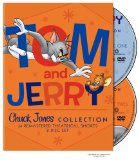In the 1930’s and 40’s MGM was trying to get in on the lucrative animation game. The field was dominated at the time by Warner Brothers with their Loony Tunes shorts, and of course, the iconic cast of animated characters coming out of the Walt Disney Studio. For years they had failed to find the right property to take advantage of the market. It wasn’t until the team of William Hanna and Joseph Barbera approached the studio with their first project that the times did change, at least a little, for the fledgling animation department at MGM. The project was far from an original one even for the time. It was a very basic cat and mouse adventure featuring a cat named Tom and a mouse named Jerry. There would be almost no dialog on the shorts. It certainly didn’t look like much of a hit to the studio brass, but with no better ideas on the way, they went ahead with the new shorts of Tom And Jerry. There’s a reason why the cat and mouse pair is such a classic. It’s because it works. If you can make your characters entertaining and endearing enough, you can have a hit. MGM finally entered the major leagues, and the team of Hanna and Barbera would become one of the most successful animation teams in history. They would go on to create such cherished characters as The Flintstones, Yogi Bear, The Jetsons, and, of course, Scooby Doo.
These were the days of the Golden Age in Hollywood. These shorts were not being produced for television, which hadn’t been invented when they began; rather they were intended for theater goers. In those days going to the movies was much more of an inclusive experience. You always got a cartoon short along with an adventure serial, the likes of Buck Rogers, Flash Gordon, and The Lone Ranger. These multi-chaptered serials were the forerunners to the modern television series. It kept you coming back to the movies to see what would happen next. Each chapter ended in a cliffhanger. These early serials were the inspiration for such film franchises as Star Wars and Indiana Jones. Finally you got one, sometimes two movies all for the price of a single admission.
Then came television, and suddenly entertainment was available in your living room for the cost of a set. It hit the movie industry hard, and cutbacks had to be made. Over the span of a couple of decades the films eventually appeared alone. Serial and animation production was winding down. MGM was hit about as hard as any other studio, and before long Tom And Jerry were on their way out. Enter Chuck Jones, the genius behind much of the Warner animation success. Warner’s cutbacks included Jones, who found himself now at MGM. Jones actually did not really want to do the Tom and Jerry shorts, and the fact that he only did 34 testifies to the fact his heart was never really in it. Still, Jones produced some of the best shorts in the series, and they are all collected in one 2 disc set.
Chuck Jones certainly imprinted his own stamp on the Tom and Jerry shorts he worked on. He tweaked the characters somewhat, and his unmistakable use of classic music to drive the action heralded back to his Loony Tunes days. From sound effects to the use of Mel Blanc to do the rare vocalizations, the duo would resemble more the Warner Brothers efforts than the previous incarnation. Here’s your chance to look at these shorts and try to find those subtle, and not so subtle, Chuck Jones touches.
Video
Each episode is presented a 1.78:1 matted format. When you consider the age, you have to be pleased with these prints. There’s a great exhibition of color here. The animation lines are smooth, and the whole thing looks near perfect. There aren’t even that many print defects to distract you here. There is unevenness in contrast and brightness, but all in all these babies are in pretty fine condition.
Audio
The Dolby Digital mono track offers pretty much dialog and music or effects. It’s fine for what it is.
Special Features
Tom And Jerry…And Chuck: (20:19) This documentary gives us a little bit of history on both Tom and Jerry and Chuck Jones. There’s a lot of great vintage interview footage with Jones himself. The piece is narrated by June Foray, who did some voice work on these cartoons.
Chuck Jones – Memories Of A Childhood: (26:11) Jones talks about his childhood and the early inspirations for his style. It’s a rather nostalgic piece with Jones providing the narration through vintage interview segments.
Final Thoughts:
You might be disappointed to hear that Jones never counted his Tom and Jerry years as a high point in his life. He appears to dismiss his work here entirely. It’s understandable when you consider it was sandwiched in between his glory years at Warner Brothers and his work on more feature presentations afterward. Even if Jones failed to appreciate what he accomplished here, we are not doomed to follow in his footsteps. If this was Jones having an off period, we should all be lucky enough to have such off days. It might not have been Jones at his best. Heck, it might not have been Tom And Jerry at their best. It was one sweet collection of toons that have survived half a century. They’re still loved by children today. And we adults, get to stroll down memory lane for a while with this collection of classic cartoons. “Yeah, yeah, yeah, yeah, yeah.”




